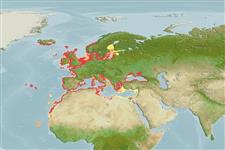Preferred temperature (Referencia
123201): 8.8 - 20, mean 11.3 °C (based on 548 cells).
Phylogenetic diversity index (Referencia
82804): PD
50 = 0.6250 [Uniqueness, from 0.5 = low to 2.0 = high].
Bayesian length-weight: a=0.00100 (0.00082 - 0.00122), b=3.10 (3.04 - 3.16), in cm total length, based on LWR estimates for this species (Ref.
93245).
Nivel trófico (Referencia
69278): 4.2 ±0.4 se; based on diet studies.
Resiliencia (Referencia
120179): Medio, población duplicada en un tiempo mínimo de 1.4-4.4 años (tm=2; Fec=1000).
Prior r = 0.43, 95% CL = 0.28 - 0.64, Based on 6 data-limited stock assessments.
Fishing Vulnerability (Ref.
59153): Moderate to high vulnerability (49 of 100).
🛈
Climate Vulnerability (Ref.
125649): High vulnerability (58 of 100).
🛈
Nutrients (Ref.
124155): Calcium = 50.7 [17.3, 178.7] mg/100g; Iron = 0.407 [0.148, 0.981] mg/100g; Protein = 17.8 [15.7, 20.3] %; Omega3 = 0.702 [0.293, 1.650] g/100g; Selenium = 9.33 [3.62, 22.32] μg/100g; VitaminA = 18.6 [5.4, 78.0] μg/100g; Zinc = 0.482 [0.202, 0.927] mg/100g (wet weight); based on
nutrient studies. 